Gather ’round young flock
and prepare yourself
For an alternative tale
of that old mystical elf,
Who goes house to house
on cold winter nights
Visiting sleeping children,
who’ve been naughty or nice.
‘Twas the eve of Saint Nicholas,
when all round about
A silence so deathly
was lurking throughout.
High ’bout the peaks
and the Austrian snow,
Came a fiend with Saint Nicholas,
whom naughty children well know.
Coarse pelts of goat hair
as its grim sickly mantles,
And a sharp wicked crown
of ram’s horns much like antlers;
Red tongue stretching long
as a slithering snake
That can strike and tear flesh;
children’s blood does it slake.
It’s the night of the Fifth
of December kids fear,
When the judgment of children
looms frightfully near.
For the beast of the holiday
weighs your virtue and vice,
And doles out its torture
based on naughty or nice.
‘Tis not falsehood, this tale
of the great Christmas Devil;
Since the dawn of the ages
in the Wild Man we revel.
Be warned that indeed
his name you should know,
For it’s Krampus today
who may well steal the show!
(©2012 Lucas Livingston, ancientartpodcast.org)
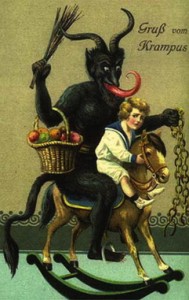 A wicked demon of lore calls home to the dark winter nights and snow-capped Alpine peaks. Clad in the coarse woolen hide of sheep and crowned with horribly twisted piercing horns, the Christmas Devil Krampus descends upon the unsuspecting at that singular time of year on the eve of the feast of jolly ole Saint Nick.
A wicked demon of lore calls home to the dark winter nights and snow-capped Alpine peaks. Clad in the coarse woolen hide of sheep and crowned with horribly twisted piercing horns, the Christmas Devil Krampus descends upon the unsuspecting at that singular time of year on the eve of the feast of jolly ole Saint Nick.
Krampus can be traced back centuries and is regarded mostly as an Austrian legend. In Austria, Germany, and other Alpine countries, the feast of Saint Nicholas on December 6th is celebrated not quite with the same fervor as Christmas, but as something of a teaser or Christmas dry run. On the night of December 5th, before going to sleep, children leave their shoes outside their bedroom doors. If you’ve been a good little boy or girl, St. Nick will come by in the night and fill your shoes with fruit, nuts, chocolate, and candy. Of course, today most snotty-faced brats will say “Yuck!” to the fruit and nuts, but this was a different time, when fruit and nuts were actually kinda special in winter. The treats in the shoes is not unlike the American tradition of hanging stockings. In both cases we have footwear serving as a vehicle for an early Christmas treat, at least in my house it was. The stocking was always fair game at 5 a.m. Christmas morning before the elders would get up.
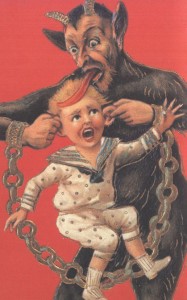 Of course, if you’ve been naughty (see aforementioned snotty-faced brats), then we might expect a lump of coal in the stocking. Well, a hard lump of coal would be too good for the rustic Germanic youth. No, lashes doled out by the devilish Krampus are what you’d deserve! Grasping a switch of birch sticks to beat disobedient kids and a sack or basket on his back to drag off the especially naughty ones, Krampus is a Yuletide reality as much as Santa Claus, himself.
Of course, if you’ve been naughty (see aforementioned snotty-faced brats), then we might expect a lump of coal in the stocking. Well, a hard lump of coal would be too good for the rustic Germanic youth. No, lashes doled out by the devilish Krampus are what you’d deserve! Grasping a switch of birch sticks to beat disobedient kids and a sack or basket on his back to drag off the especially naughty ones, Krampus is a Yuletide reality as much as Santa Claus, himself.
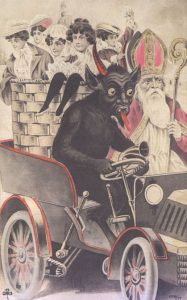 Krampus and Saint Nick are not adversaries. In fact, they’re very much a tag team. In Santa’s sleigh, Krampus rides shotgun, or sometimes the other way around. Krampus is one of Saint Nick’s many companions among various European traditions. Like Krampus, some of his companions form a stark contrast to the pristine, jolly, child-friendly, gift-giver. In the German Rhineland we find the fur-clad Belsnickel, who’s also popular among America’s Pennsylvania Dutch. In much of the rest of Germany, the gentler, bearded, brown-robed, Santa-like Knecht Ruprecht (Farmhand Rupert or Servant Rupert) can be seen helping out Saint Nicholas. His dirty robes and ashen face are smeared with the soot of chimneys from his special deliveries. And most popular even today throughout Belgium and the Netherlands is Zwarte Piet or Schwarz Peter. This finely dressed lad with a similarly sooty face also doles out Saint Nick’s treats. According to some historians, in fact, the companion giver of both gifts and punishments may be the more likely model for today’s Western consumerist Santa Claus, rather than some pious 4th century Turkish bishop. [1]
Krampus and Saint Nick are not adversaries. In fact, they’re very much a tag team. In Santa’s sleigh, Krampus rides shotgun, or sometimes the other way around. Krampus is one of Saint Nick’s many companions among various European traditions. Like Krampus, some of his companions form a stark contrast to the pristine, jolly, child-friendly, gift-giver. In the German Rhineland we find the fur-clad Belsnickel, who’s also popular among America’s Pennsylvania Dutch. In much of the rest of Germany, the gentler, bearded, brown-robed, Santa-like Knecht Ruprecht (Farmhand Rupert or Servant Rupert) can be seen helping out Saint Nicholas. His dirty robes and ashen face are smeared with the soot of chimneys from his special deliveries. And most popular even today throughout Belgium and the Netherlands is Zwarte Piet or Schwarz Peter. This finely dressed lad with a similarly sooty face also doles out Saint Nick’s treats. According to some historians, in fact, the companion giver of both gifts and punishments may be the more likely model for today’s Western consumerist Santa Claus, rather than some pious 4th century Turkish bishop. [1]
And not all of Saint Nick’s companions are human (of a sort). The saint is popularly said to ride upon a brilliant white steed, usually a horse, but sometimes a goat. The Yule Bock or Yule Goat is a popular Yuletide feature in Scandinavia. Made out of straw today, the Yule Goat is customarily set ablaze as a ritual reenactment of goat sacrifice during the pagan festival of Yule. And that pagan goat sacrifice is thought to be the celebration of an ancient Nordic legend. As chronicled in the 13th century Prose Edda, the god Thor drove his chariot drawn by two goats across the sky. Thor slaughtered the goats to feed his fellow gods and summarily resurrected the animals through the magic of his hammer. In the 1890 pioneering comparative study of mythology and religion, The Golden Bough, Sir James Frazer documents a Swedish performance of a man clad in goat hides as the Yule Goat:
The actor, hidden by a coverlet made of skins and wearing a pair of formidable horns, is led into the room by two men, who make believe to slaughter him, while they sing verses… At the conclusion of the song, the Yule Goat, after feigning death, jumps up and skips about to the amusement of the spectators. [2]
Could Austria’s fur-clad Krampus and the Scandinavian Yuletide goat-man have a common pagan ancestor? Krampus and the Christmas Devil get some attention in the 1835 German Mythology (Deutsche Mythologie, also commonly translated as Teutonic Mythology) by Jacob Grimm, one half of the famed titans of folk and fairy tales, the Brothers Grimm. While Krampus gets only a passing nod, our takeaway from Grimm’s analysis can be that the various threatening and sooty sidekicks of Saint Nicholas stem from Europe’s pre-Christian pagan festivals. And while they may have been incorporated into Christian, Christmastime, gift-giving narratives, these figures inevitably regress to exhibit some of their vestigial heathen characteristics. [3]
Despite the Church’s best efforts to stamp out or convert these Old World pagan elements, Krampus is alive and well during the Feast of Saint Nicholas. Krampus enjoyed an especially popular revival in the early 20th century as a fixture on greeting cards. Customarily expressing “Grüß vom Krampus” — “Greetings from Krampus!” — these cards served as something of a cautionary tale against the perils of misbehavior. We generally see Krampus exacting his punishment on naughty children, stealing them away in baskets or shackles, threatening them with his switch, and pulling on their ears. Inscriptions tell the recipients to be “brav” (obedient), [27] or they reprimand the unlucky, “weilst schlimm warst!” (“because you’ve been naughty!”) [29]
And still today, on the night of December 5th, amidst glowing candles and glorious aromas wafting through traditional Christmas markets in charming Austrian old town centers, rambunctious young men don costumes of fur, chains, bells, and horns to become Krampus for one exciting night of the Krampuslauf. You might call it a “Krampus Parade” or the “Running of the Krampus.” The Krampuslauf is not only extremely popular in present-day Austria, but it’s even making headway in American cities like Philadelphia with krampuslaufphiladelphia.com. The American Krampuslauf justifiably takes on a family-friendly nature. In the Austrian Krampuslauf, however, unfettered by American litigiousness, people would be well advised to keep their distance, as Krampus won’t hesitate to invade your personal space. And that can mean some serious wallops from a stinging whip.
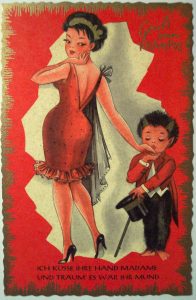 With his bad-boy attitude and devilish good looks, Krampus also enjoys the reputation of being something of a ladies’ man. While a night at the Krampuslauf can leave the men with some bruises, the furry beast is more inclined to woo the ladies with a few strategic, teasing taps of his switch. And I’m sure all the ladies daydream of a dark, muscular rogue stealing into their bedchambers to abduct and punish them for being very naughty girls! And imaginations can run wild with that impossibly long tongue.
With his bad-boy attitude and devilish good looks, Krampus also enjoys the reputation of being something of a ladies’ man. While a night at the Krampuslauf can leave the men with some bruises, the furry beast is more inclined to woo the ladies with a few strategic, teasing taps of his switch. And I’m sure all the ladies daydream of a dark, muscular rogue stealing into their bedchambers to abduct and punish them for being very naughty girls! And imaginations can run wild with that impossibly long tongue.
So with December 5th just around the bend
Or at most a year away,
Consider well whether your deeds to amend.
For it’s not on Christmas Day
When a nighttime visit from a dark mystical elf
Judges you naughty or nice.
No, punishment stems from fierce Krampus himself;
Let’s hope you’re not on thin ice!
(©2012 Lucas Livingston, ancientartpodcast.org)
I hope you’ve enjoyed our holiday feature. For more Krampus goodies, visit ancientartpodcast.org/krampus, where you’ll find links to some of the best Krampus videos and resources on the Internet, the transcript and footnotes for this video (including our fun, little poems), and a gallery with credits for all the images and audio from this episode — and for the seriously interested, you’ll also find some great references for further reading. I also recommend you check out krampus.com, which hosts a significant gallery of vintage Krampus greeting cards.
Thanks for tuning in to the Ancient Art Podcast. You can like the podcast at facebook.com/ancientartpodcast and follow me on Twitter @lucaslivingston. If you enjoy the podcast, please share it with your friends and give us a big thumb up on YouTube, iTunes, and Vimeo. I always love hearing from you on Facebook and YouTube. You can also email me at info@ancientartpodcast.org or send me your feedback on the web at feedback.ancientartpodcast.org. Thanks for tuning in and see you next time on the Ancient Art Podcast.
©2012 Lucas Livingston, ancientartpodcast.org
———————————————————
Footnotes:
[1] Smith, John B., “Perchta the Belly-Slitter, and Her Kin: A View of Some Traditional Threatening Figures, Threats and Punishments,” Folklore, Vol 115, No. 2 (Aug., 2004), pp. 167-186.
In his study, Widdowson distinguishes three types of threatening figure. Class A comprises supernatural, fictitious and invented figures; Class B is made up of human beings with unusual characteristics; Class C consists of animals, objects, locations and natural phenomena (Widdowson 1977, 95). Among the threatening figures in Class A is, for instance, Santa Claus. To see him as such may seem strange, but he immediately qualifies when we realise that,in Newfoundland at least, he will take naughty children away in his sack or, in lieu of presents,leave them unpleasant objects in their stockings. Such punitive behaviour is not all that remote from that of Perchta and some of her counterparts or helpers such as Krampus or Knecht Ruprecht. (p. 178)
[2] “Yule Goat,” Wikipedia. Retrieved 2 December, 2012.
For a similar Yuletide practice of transforming and concealing once’s appearance:
On the South Shore of Nova Scotia, Canada, a Christmas tradition known as Belsnickling occurs, where, similar to mummering, people go from house to house within the communities dressed in multiple layers of clothing and with scarves around their faces to conceal their identity. These people are then given food and drinks (usually rum or eggnog) until their identities are guessed, and then they’re off to the next house.
“Companions of Saint Nicholas,” Wikipedia. Retrieved 2 December, 2012.
Also:
In Whittlesey, near Peterborough in East Anglia, the traditions of the Bear, the mummers plays, wassailing, and general midwinter tomfoolery combine into the Whittlesey Strawbear Festival. A man is costumed all in the very best straw from the local farms and touted around from house to house demanding money and booze before leading the circle-dance festivities and, eventually, being burned (just the costume, sans person, we hope) to make way for the following year’s crop.
“Santa: Last of the Wild Men,” The Old Weird Albion. Retrieved 2 December, 2012.
… it is a darkening and distortion of their original nature in accordance with Christian sentiment. So it becomes clear, at last, how the once familiar and faithful friend of the family under heathenism has gradually sunk into a bugbear or a taunt to children: a lot which he shares with goddesses and gods of old. … And it is worth remarking how, in some districts at least, knecht Ruprecht, knecht Nicolas, appear at Christmas-time not by themselves, but in attendance on the real gift-giver, the infant Christ or dame Berhta: while these dole out their favours, those come on with rod and sack, threatening to thrash disobedient children, to throw them into the water, to puff their eyes out. … I can well imagine that even in heathen times the divinity, whose appearing heralded a happy time, had at his side some merry elf or dwarf as his attendant. … In Christian times they would at first choose some saint to accompany the infant Christ or the mother of God in their distribution of boons, but the saint would imperceptibly degenerate into the old goblin again, but now a coarser one. The Christmas plays sometimes present the Saviour with His usual attendant Peter, or else with Niclas, at other times however Mary with Gabriel, or with her aged Joseph, who, disguised as a peasant, acts the part of knecht Ruprecht. Nicolaus again has converted himself into a ‘man Clobes’ or Rupert ; as a rule, it is true, there is still a Niclas, a saintly bishop and benevolent being, distinct from the ‘man’ who scares children; but the characters get mixed, and Clobes by himself acts the ‘man’; the Austrian Grampus, Krämpus, Krambas, is possibly for Hieronymus, but how to explain the Swiss Schmutzli I do not rightly know, perhaps simply from his smutty sooty aspect? Instead of Grampus there is also in Styria a Barthel (pointing to Berhta, or Bartholomew?) Schmutzbartel and Klaubauf, who rattles, rackets, and throws nuts. Further, on this point I attach weight to the Swedish jullekar, Dan. juleleger, yule-lays, undoubtedly of heathen origin, which at Christmastime present Christ and certain saints, but replace our man Ruprecht by a julbock, julebuk, i.e. a manservant disguised as a goat. This interweaving of jackpudding, fool, Klobes and Rüpel, of the yule-buck and at last of the devil himself, into the rude popular drama of our Middle Ages, shows what an essential part of it the wihtels and tatermans formerly were, how ineradicable the elvish figures and characters of heathenism. The Greeks enlivened the seriousness of their tragedy by satyric plays, in which e.g. Proteus, similar to our sea-sprite, played a leading part.
For the notes to this section, see Teutonic Mythology, Volume 4, p. 1436. (PDF p. 172).
See also Chapter 4: “Satan Dons Furs” in Phyllis Siefker, Santa Claus, Last of the Wild Men: The Origins and Evolution of Saint Nicholas, Spanning 50,000 Years, Jefferson: McFarland & Company, Inc., 1997. Also page 15:
It seems obvious, therefore, that Santa Claus can be neither the alter ego of Saint Nicholas nor the brainchild of Washington Irving. . . If we peek behind the imposing Saint Nicholas, we see, glowering in the shadows, the saint’s reprobate companion, Black Pete. He, like Santa, has a coat of hair, a disheveled beard, a bag, and ashes on his face. . . In fact, it is this creature, rather than Irving’s creation or an Asian saint, who fathered Santa Claus.
———————————————————
See the Photo Gallery for detailed photo credits.
Media courtesy of:
Apple Garageband
youtube.com/user/footageisland
krampus.com
krampuslaufphiladelphia.com
musopen.org
gutenberg.org
colonialsense.com
archive.org
Wikimedia Commons:
Albärt, Hayden120, Keith Edkins, Michell Zappa, San Jose
flickr:
Allie_Caulfield, Andreas Schalber, burnlab, celesteh, Der_Krampus, elisabetta2005, geek7, gholzer, girl_onthe_les, Giulio GMDB, goodiesfirst, Hanna Alicé, hans s, herbraab, HERRUWE, klachak, leo.laempel, loop_1, misterbisson, NiceBastard, patze001, pixel0908, plastAnka, PsychoScheiko, riptheskull, Udo Schröter, Vincenzo Caico, wege7, Weiko
The Freesound Project, freesound.org:
benjaminflack, DJ Chronos, hammerklavier, metamorphmuses

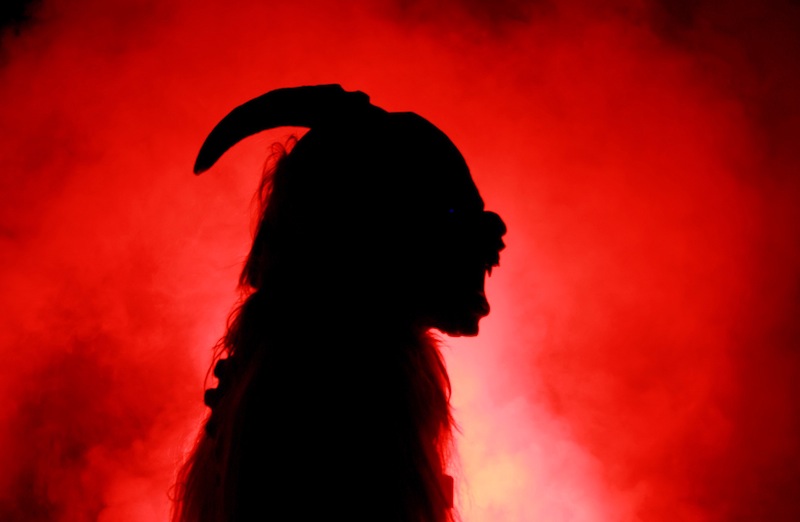

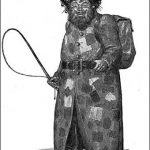
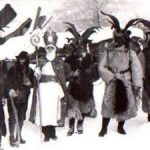
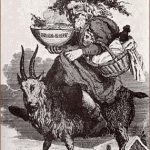

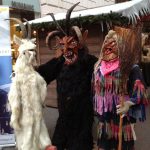
Excellent! Thanks for sharing! And thanks for watching.